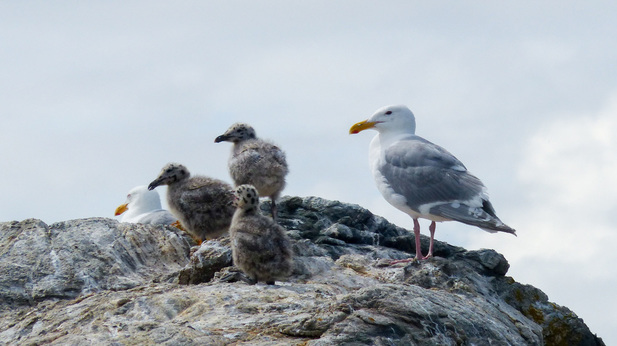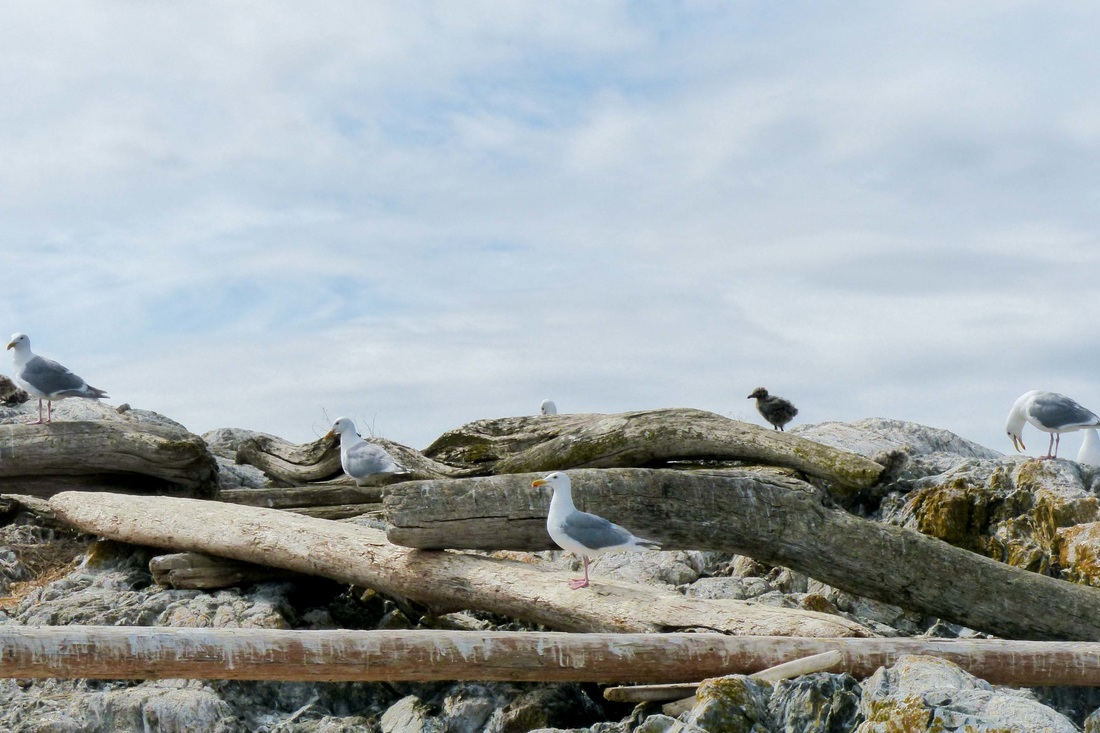Glaucous-winged gull • Larus glaucescens
Heiltsuk/Haíɫzaqv - c̓ígíláǧa • Nuxalk - qw'litq (seagull)
Identification
The glaucous-winged gull is one of a number of similar-looking gulls. It is a large gull, and in breeding plumage it has a clean white head, neck, underparts, and tail; its back and most of the tops of its wings are a light silvery grey, and its wingtips are grey with white spots near the ends. Its legs are pinkish and it has a red spot on its lower bill. The adult non-breeding plumage is similar but less bright and crisp: the head, neck, and breast are streaked or smudged with a brownish hue, and the legs and bill are duller and paler. The plumage of immature glaucous-winged gulls is quite different, and evolves as the bird ages. Click here for a detailed description of each developmental stage.
Habitat & Range
The glaucous-winged gull mostly inhabits coastal habitats, and is commonly found around beaches, rocky shorelines, estuaries, and bays, though it also may be seen around ponds, fields, buildings, and garbage dumps near the coast. This gull is a year-round resident on the Central Coast. This resident range extends along much of the Pacific Northwest and through the Aleutian Islands. Some move south to a winter range along the coast from Oregon to Baja California, and some that breed along more northern coastlines in Alaska retreat further south for winter. Click here for a range map, and visit the BC Breeding Bird Atlas for more information on its distribution in British Columbia.
Similar Species
This gull may be tricky for the untrained eye to differentiate from similar gulls such as the herring gull, the California gull, the glaucous gull, and the western gull, however unlike the glaucous-winged gull these species are not found on the Central Coast year-round. Click here for a comparison of the glaucous-winged gull with other similar species; some notable differences are the glaucous gull's white wingtips and the western gull's darker back and black wingtips. To further complicate matters, the glaucous-winged gull hybridizes with the western and herring gulls in some regions along the Pacific coast.
iNaturalist
https://www.inaturalist.org/taxa/4399-Larus-glaucescens
The glaucous-winged gull is one of a number of similar-looking gulls. It is a large gull, and in breeding plumage it has a clean white head, neck, underparts, and tail; its back and most of the tops of its wings are a light silvery grey, and its wingtips are grey with white spots near the ends. Its legs are pinkish and it has a red spot on its lower bill. The adult non-breeding plumage is similar but less bright and crisp: the head, neck, and breast are streaked or smudged with a brownish hue, and the legs and bill are duller and paler. The plumage of immature glaucous-winged gulls is quite different, and evolves as the bird ages. Click here for a detailed description of each developmental stage.
Habitat & Range
The glaucous-winged gull mostly inhabits coastal habitats, and is commonly found around beaches, rocky shorelines, estuaries, and bays, though it also may be seen around ponds, fields, buildings, and garbage dumps near the coast. This gull is a year-round resident on the Central Coast. This resident range extends along much of the Pacific Northwest and through the Aleutian Islands. Some move south to a winter range along the coast from Oregon to Baja California, and some that breed along more northern coastlines in Alaska retreat further south for winter. Click here for a range map, and visit the BC Breeding Bird Atlas for more information on its distribution in British Columbia.
Similar Species
This gull may be tricky for the untrained eye to differentiate from similar gulls such as the herring gull, the California gull, the glaucous gull, and the western gull, however unlike the glaucous-winged gull these species are not found on the Central Coast year-round. Click here for a comparison of the glaucous-winged gull with other similar species; some notable differences are the glaucous gull's white wingtips and the western gull's darker back and black wingtips. To further complicate matters, the glaucous-winged gull hybridizes with the western and herring gulls in some regions along the Pacific coast.
iNaturalist
https://www.inaturalist.org/taxa/4399-Larus-glaucescens
References
Barry, K.L. 2015. Glaucous-winged Gull. In Davidson, P.J.A., R.J. Cannings, A.R. Couturier, D. Lepage, and C.M. Di Corrado (eds.). The Atlas of the Breeding Birds of British Columbia, 2008-2012. Bird Studies Canada. Delta, B.C.
Dunn, J. L. and Alderfer, J. (Eds.). (2011). National Geographic Field Guide to the Birds of North America. (6th Ed.). Washington, D.C.: National Geographic Society. Pp. 228-229.
Glaucous-winged Gull Larus glaucescens. Audubon Guide to North American Birds. Accessed 19/04/2018.
Glaucous-winged Gull Larus glaucescens. The Birds of North America Online (A. Poole, Ed.). Ithaca: Cornell Lab of Ornithology. Retrieved from the Birds of North America Online. Accessed 19/04/2018.
http://linnet.geog.ubc.ca/efauna/Atlas/Atlas.aspx?sciname=Larus%20glaucescens
Authors and editors of page
Kelly Fretwell (2018).
Barry, K.L. 2015. Glaucous-winged Gull. In Davidson, P.J.A., R.J. Cannings, A.R. Couturier, D. Lepage, and C.M. Di Corrado (eds.). The Atlas of the Breeding Birds of British Columbia, 2008-2012. Bird Studies Canada. Delta, B.C.
Dunn, J. L. and Alderfer, J. (Eds.). (2011). National Geographic Field Guide to the Birds of North America. (6th Ed.). Washington, D.C.: National Geographic Society. Pp. 228-229.
Glaucous-winged Gull Larus glaucescens. Audubon Guide to North American Birds. Accessed 19/04/2018.
Glaucous-winged Gull Larus glaucescens. The Birds of North America Online (A. Poole, Ed.). Ithaca: Cornell Lab of Ornithology. Retrieved from the Birds of North America Online. Accessed 19/04/2018.
http://linnet.geog.ubc.ca/efauna/Atlas/Atlas.aspx?sciname=Larus%20glaucescens
Authors and editors of page
Kelly Fretwell (2018).







